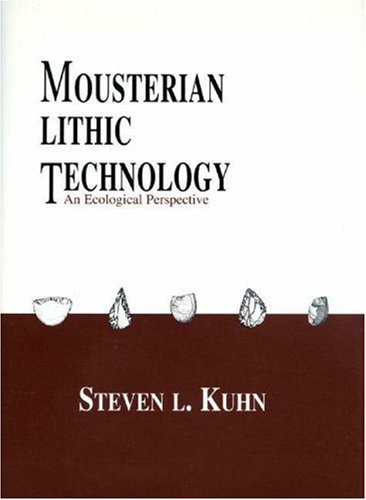Articles liés à Mousterian Lithic Technology: An Ecological Perspective

Synopsis
Human beings depend more on technology than any other animal-the use of tools and weapons is vital to the survival of our species. What processes of biocultural evolution led to this unique dependence? Steven Kuhn turns to the Middle Paleolithic (Mousterian) and to artifacts associated with Neandertals, the most recent human predecessors. His study examines the ecological, economic, and strategic factors that shaped the behaviour of Mousterian tool makers, revealing how these hominids brought technological knowledge to bear on the basic problems of survival. Kuhn's main database consists of assemblages of stone artifacts from four caves and a series of open-air localities situated on the western coast of the Italian peninsula. Variations in the ways stone tools were produced, maintained, and discarded demonstrate how Mousterian hominids coped with the problems of keeping mobile groups supplied with the artifacts and raw materials they used on a daily basis. Changes through time in lithic technology were closely tied to shifting strategies for hunting and collecting food. Some of the most provocative findings of this study stem from observations about the behavioural flexibility of Mousterian populations and the role of planning in foraging and technology.
Les informations fournies dans la section « Synopsis » peuvent faire référence à une autre édition de ce titre.
Présentation de l'éditeur
Human beings depend more on technology than any other animal--the use of tools and weapons is vital to the survival of our species. What processes of biocultural evolution led to this unique dependence? Steven Kuhn turns to the Middle Paleolithic (Mousterian) and to artifacts associated with Neanderthals, the most recent human predecessors. His study examines the ecological, economic, and strategic factors that shaped the behavior of Mousterian tool makers, revealing how these hominids brought technological knowledge to bear on the basic problems of survival. Kuhn's main database consists of assemblages of stone artifacts from four caves and a series of open-air localities situated on the western coast of the Italian peninsula. Variations in the ways stone tools were produced, maintained, and discarded demonstrate how Mousterian hominids coped with the problems of keeping mobile groups supplied with the artifacts and raw materials they used on a daily basis. Changes through time in lithic technology were closely tied to shifting strategies for hunting and collecting food. Some of the most provocative findings of this study stem from observations about the behavioral flexibility of Mousterian populations and the role of planning in foraging and technology. Originally published in 1995. The Princeton Legacy Library uses the latest print-on-demand technology to again make available previously out-of-print books from the distinguished backlist of Princeton University Press. These paperback editions preserve the original texts of these important books while presenting them in durable paperback editions. The goal of the Princeton Legacy Library is to vastly increase access to the rich scholarly heritage found in the thousands of books published by Princeton University Press since its founding in 1905.
Les informations fournies dans la section « A propos du livre » peuvent faire référence à une autre édition de ce titre.
EUR 9,08 expédition depuis Etats-Unis vers France
Destinations, frais et délaisRésultats de recherche pour Mousterian Lithic Technology: An Ecological Perspective
Mousterian Lithic Technology : An Ecological Perspective
Vendeur : Better World Books, Mishawaka, IN, Etats-Unis
Etat : Good. First Edition. Former library book; may include library markings. Used book that is in clean, average condition without any missing pages. N° de réf. du vendeur 8018709-6
Quantité disponible : 1 disponible(s)
Mousterian Lithic Technology
Vendeur : Powell's Bookstores Chicago, ABAA, Chicago, IL, Etats-Unis
Etat : Used - Very Good. 1995. Hardcover. Very Good. Dust Jacket is Fine. N° de réf. du vendeur C48774
Quantité disponible : 5 disponible(s)
Mousterian Lithic Technology: An Ecological Perspective.
Vendeur : Plurabelle Books Ltd, Cambridge, Royaume-Uni
Hardback. Etat : Very Good. xiv 209p large format hardback, fresh white and brown jacket, excellent fresh copy, as new Language: English. N° de réf. du vendeur 232290
Quantité disponible : 1 disponible(s)
Mousterian Lithic Technology (Princeton Legacy Library, 301)
Vendeur : Idaho Youth Ranch Books, Boise, ID, Etats-Unis
Etat : Good. A copy that has been read, but remains in clean condition. All pages are intact, and the cover is intact (including dust cover, if applicable). The spine may show signs of wear. Pages can include limited notes and highlighting, and the copy can include "From the library of" labels or limited small stickers. Book may have a remainder mark or be a price cutter. N° de réf. du vendeur AU-01-07-03-0306
Quantité disponible : 1 disponible(s)

